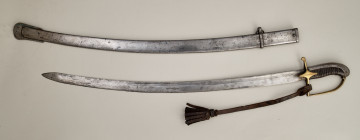
Battle saber
20th century
Castle Museum in Łańcut
Part of the collection: History of the city and the region
Mauser 98 was the primary firearm used by mounted riflemen. The 10th Mounted Rifle Regiment used them as an issue weapon since 1927. It was based on the German Gewehr 98 and 98b, but made in Poland, firing 7.92 mm ammunition. The rifle had a 5-bullet clip, weighed 4.2 kilograms – adding the bayonet got the weight to 4.9 kilograms – and had an effective firing range of up to 800 metres with a muzzle velocity of about 895 m/s. The history of Mausers dates back to the 1870s, when the company founded by brothers Wilhelm and Paul Mauser became a renowned supplier of rifles and carbines for the German army, supplying foreign forces with small arms as well. They improved upon their designs by introducing innovative solutions, which eventually culminated in making the factory’s most famous design – the Gewehr 98, its 1898 model. It was a bolt-action rifle with a clip – it required manual reloading after every shot. Its bolt action mechanism required the shooter to perform four hand movements to load the cartridge. The history of the Polish Mausers begins in 1921, when by the decision of the Council of Ambassadors the equipment of the Gdańsk rifle factory was granted to Poland. In 1922, the Gerlach plant in Warsaw’s Wola district, later renamed the State Rifle Factory, started making a faithful copy of the German 1898 design. In the 1930s, they were also manufactured at the newly established Weapons Factory in Radom, where the presented Mauser comes from. Altogether, in the interwar period Polish factories produced over 700,000 rifles and carbines based on the Mauser system. Many of them, hidden after the defeat in September 1939, were later used by the underground partisans. Joanna Kluz Works cited: Kucia P., 10. Pułk Strzelców Konnych 1918-1947, część I, Warsaw.
Author / creator
Dimensions
height: 110 cm
Object type
History of the city and the region
Technique
mill forming, installation
Material
wood, metal
Creation time / dating
Creation / finding place
Owner
Castle Museum in Łańcut
Identification number
Location / status